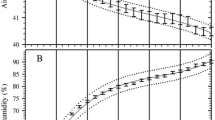Summary
18 highly acclimatized Bantu and four different groups of 20 unacclimatized Bantu worked continuously for 4 hours at an oxygen consumption of 1.0 litre/min at 72, 82, 86 and 90 ° Effective Temperatures (E.T.). Rectal temperatures of theacclimatized men plotted against time showed that at 72 and 82 ° E.T., rectal temperatures rise from resting levels to a new steady level of 99.7 ° F within one hour and remain at that level for 4 hours; at 86 ° and 90 ° E.T. new, higher steady levels were reached but it took longer to do so. The steady level of rectal temperature ofunacclimatized men at 72 ° E.T. was higher, 100.1–100.3 °F; at 82 ° E.T. a new, higher level was reached only after 2 hours and at 86 and 90 ° E.T. rectal temperature continued to rise, throughout the period. Sweat rates plotted against time showed the expected maximum value in the second hour with a rapid fall-off thereafter, especially at severe heat conditions. The levels of the unacclimatized men were all lower.
Plots of sweat rates/rectal temperature, based both on the hourly measurements and on the averages for the 4 hours of exposure, show the expected trends which are a) an initial rapid rise in sweat rate with increase in rectal temperature, the “sensitive” zone and b) a fall-off in sweat rate with further rise in rectal temperature, the “saturation” zone. Curves fitted to these plots, with 83% confidence limits, show the following differences between acclimatized and unacclimatized men, a) the slopes of the initial part of the curves are steeper in the acclimatized men b) the origin of the curve of the unacclimatized men is shifted to the right by over 0.8 °F, c) the maximum, or saturation level, of sweat rate in the acclimatized men is much higher, d) the curves of the acclimatized men are significantly different from those of the unacclimatized men (at 5% level).
This test procedure distinguishes sensitively and significantly between acclimatized and unacclimatized men in this particular temperature regulatory mechanism.
These data show that the results are highly reproducible; that a maximum of 4 different air conditions are needed; that a minimum of 3 hours of exposure is required; and that a minimum sample often men is needed at each of the air conditions.
Similar content being viewed by others
References
Bass, D. E.: Acclimatization to heat. In: Temperature, its measurement and control in Science and Industry, Vol. 3, Part 3. New York: Reinhold 1963.
Bedford, T.: Environmental warmth and its measurement. Med. Res. Council War memo No.17, London: H. M. S. 0. 1946.
Benziger, T. H.: Physical heat regulation and the sense of temperature in man. Proc. nat. Acad. Sci. (Wash.)45, 645–659 (1959).
Lind, A. R.: A physiological criterion for setting thermal environmental limit for everyday work. J. appl. Physiol.18, 51–56 (1963).
, andD. E. Bass: Optimal exposure time for development of acclimatization to heat. Fed. Proc.22, 704–708 (1963).
Robinson, S., E. S. Turrell, H. S. Belding, andS. M. Horvath: Rapid acclimatization to work in hot climates. Amer. J. Physiol.140, 168–176 (1943).
van Graan, C. H., andC. H. Wyndham: Body surface area in human beings. Nature (Lond.)204, 998 (1964).
Wyndham, C. H.: The adaptation of some ethnic groups in Southern Africa to heat, cold and exercise. S. Afr. J. med. Sci.61, 11–29 (1965).
: The role of skin and core temperature in man's temperature regulation. J. appl. Physiol.20, 31–36 (1965).
: A survey of causal factors in heat stroke and of their prevention in the gold mining industry. J. Instit. Min. Met. (S.A.)66, 125–155 (1965).
— The effect of acclimatization on the sweat rate/rectal temperatures relationship. (Submitted to J. appl. Physiol.)
,J. F. Morrison, J. S. Ward, G. A. G. Bredell, M. J. E. von Rahden, L. Holdsworth, andH. Wenzel: Physiological reactions to cold of Bushmen, Bantu and Caucasian males. J. appl. Physiol.19, 868–876 (1964).
,N. B. Strydom, J. F. Morrison, F. D. du Toit, andJ. G. Kraan: Responses of unacclimatized men under stress of work and heat. J. appl. Physiol.6, 681–686 (1954).
: A new method of acclimatization to heat. Arbeitsphysiologie15, 373–382 (1954).
,C. G. Williams, G. A. G. Bredell, M. J. E. von Rahden, L. Holdswobth, C. H. van Graan, andA. Munro: Heat reactions of Caucasians Bantu and in South Africa. J. appl. Physiol.19, 598–606 (1964).
,J. S. Maritz, andA. H. Munro: Criteria for physiological limits for work in heat. J. appl. Physiol.20, 37–45 (1965).
C. G.Williams, J. F.Morrison, and G. A. G.Bredell: Comparison of multi stress tests in the sweat rate/rectal temperature relationship. (In print.)
Author information
Authors and Affiliations
Rights and permissions
About this article
Cite this article
Wyndham, C.H., Strydom, N.B., Williams, C.G. et al. The heat reactions of bantu males in various states of acclimatization. Int. Z. Angew. Physiol. Einschl. Arbeitsphysiol. 23, 63–78 (1966). https://doi.org/10.1007/BF00716283
Received:
Issue Date:
DOI: https://doi.org/10.1007/BF00716283




